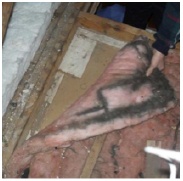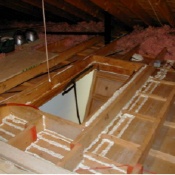
An Introduction to Air Sealing
What Is Air Leakage?
Air leakage is outside air that enters a house typically through cracks and other openings. This happens year round causing in-consistent room temperatures. The biggest impact comes from warm air leaking (infiltration) into your home during the summer and out of your home in the winter (exfiltration). Doors and win-dows can be hot spots for leaks, but more often air escapes through attic penetrations, electrical outlets, and lighting fixtures.
Air sealing the attic has the biggest impact on reducing the home’s overall air leakage rate. Air sealing also helps improve the performance of your insulation.
Benefits of Air Sealing
- Savings on heating and cooling costs
- Healthier indoor environment with better air quality
- Increased comfort in home with consistent temperatures
- Smaller heating/cooling equipment needed
Air leakage can account for up to 20% or more of a home’s heating and cooling costs. It can also cause problems such as moisture, noise, dust, and the entry of pollutants. Although insulation is extremely effective at reducing heat loss through conduction, it does not stop air movement. Both insulation and air sealing should be done together to effectively improve home performance and reduce heat loss.
What Are the Priorities for Air Sealing?
Although windows, doors, and outside walls contribute to air leakage, the biggest holes are usually hidden from view in areas that connect the house to the attic, crawlspace, or basement. The key is to identify these areas and air seal them properly. Typically, the big holes should be sealed first, then the large cracks and penetrations, and finally the smaller cracks and seams. By doing so, you reduce the stack effect, which occurs in a home when air rises up and out of the living space through holes and cracks. This air is replaced with the outside air that enters through holes in the lower portion of the home. This process is shown in the picture above.
What Is a Blower Door?
A blower door is a large fan that depressurizes the home and measures the air leaks using highly sensitive pressure gauges .It is a valuable diagnostic tool used to identify major areas of air leakage when air sealing a home.
What Is Combustion Safety Testing?
Combustion safety testing is a process that tests the furnace or boiler, gas water heater, and gas range/oven for the presence of dangerous carbon monoxide (CO) and checks the operation of the venting system or chimney. If these appliances produce high levels of CO and the vent systems are ineffective, tightening up the house can be dangerous. Every home should be screened for these problems before and after air sealing is completed.
 Before Air Sealing
Before Air Sealing
Once outside air enters into the house, it collects the dust in the air. When that air moves throughout the house and travels into the attic, the dirt in the air is actually filtered out by the insulation, causing discoloration.
 After Air Sealing
After Air Sealing
Here is an example of how air sealing should be performed. Once it is properly completed, leakage will be reduced.

